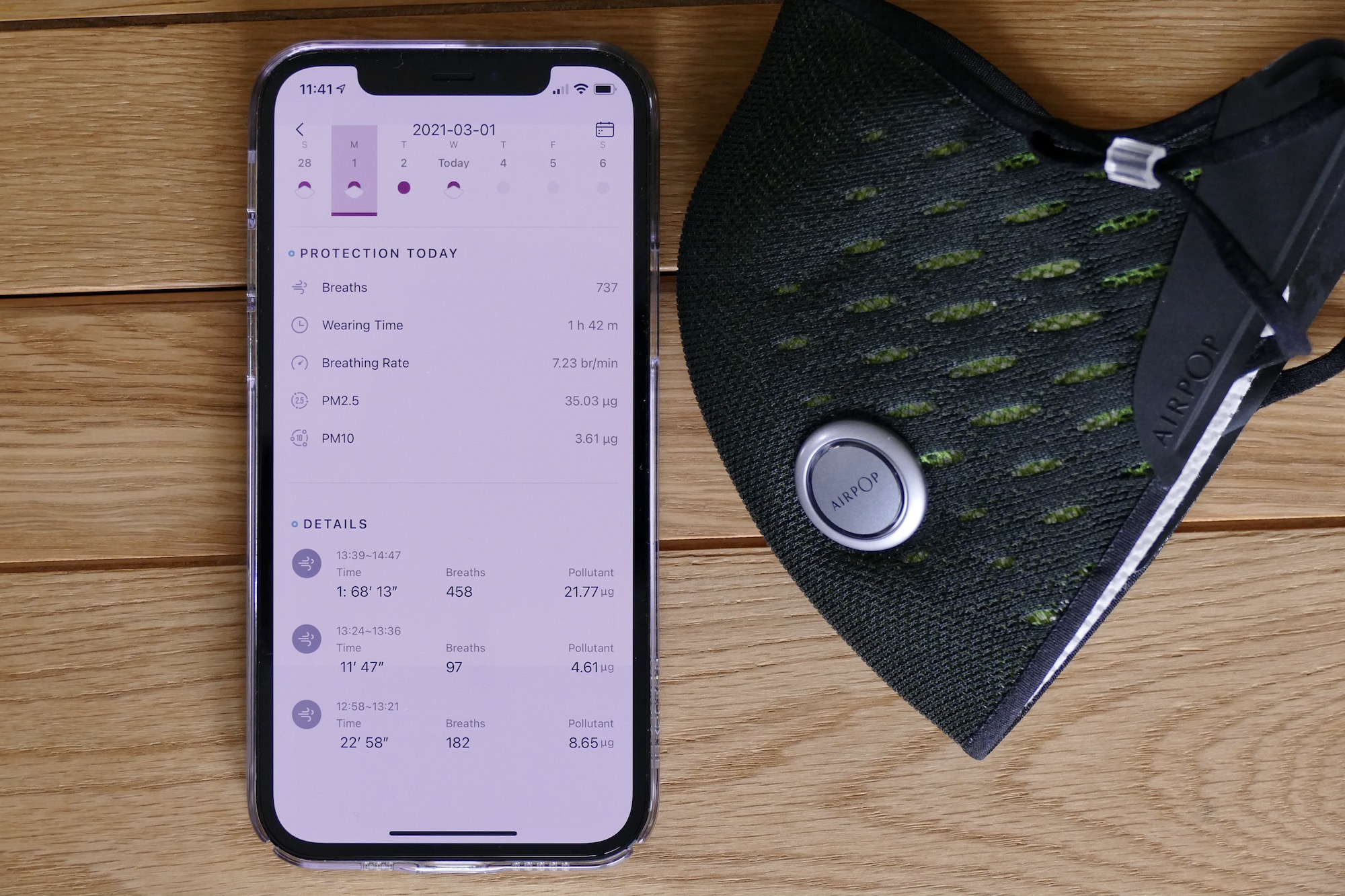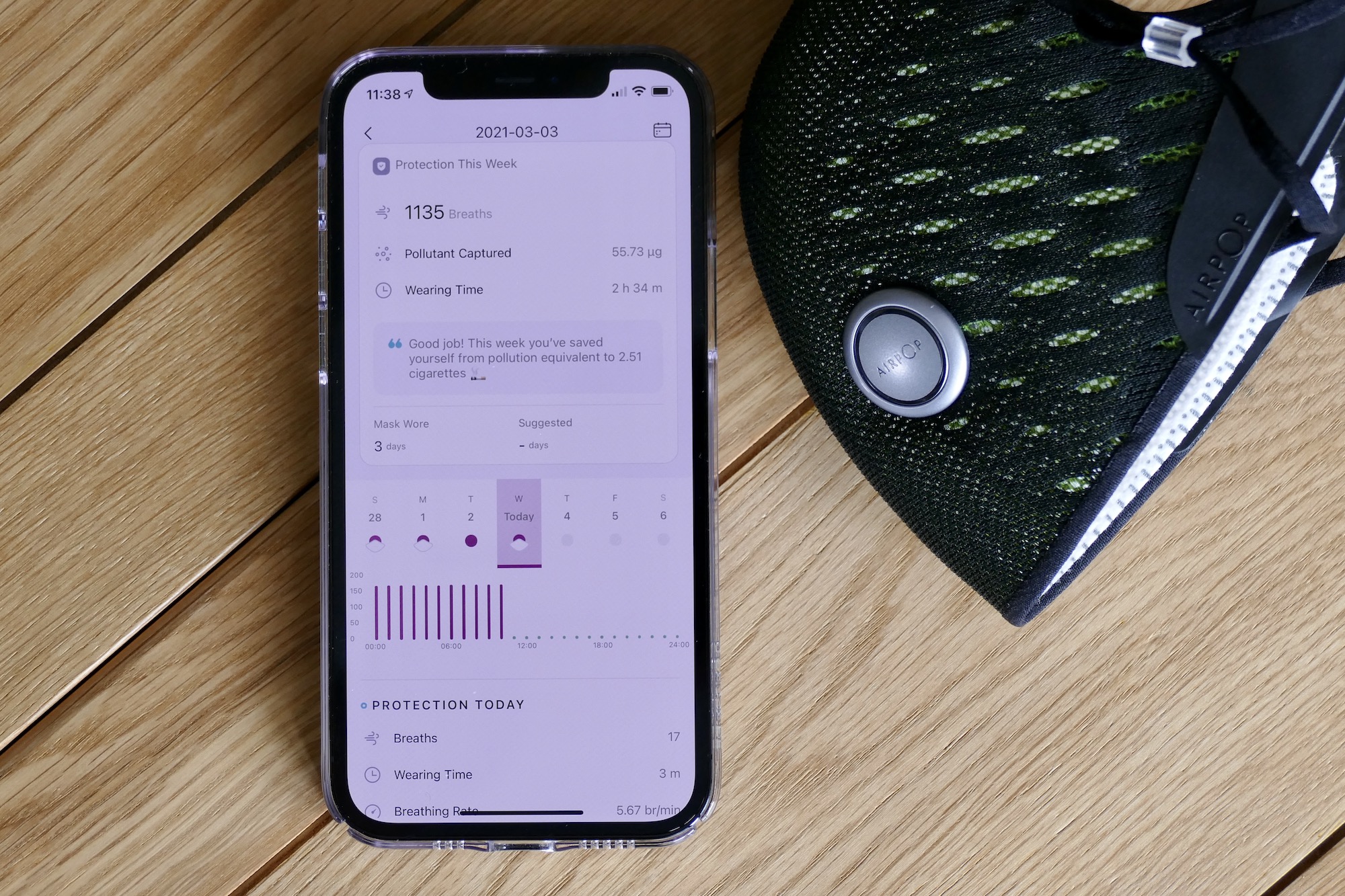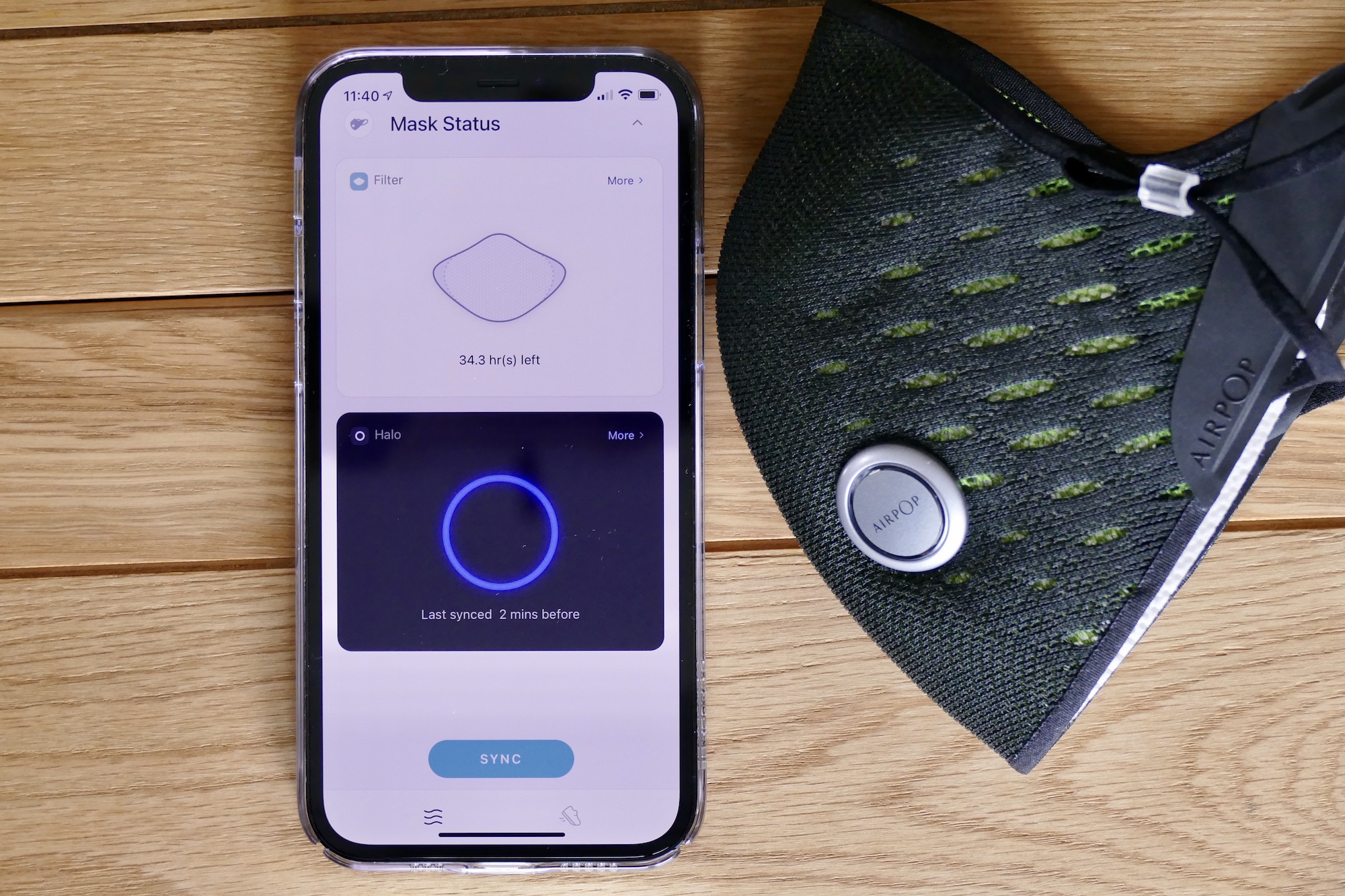What possible reason could there be to spend $150 on a “smart” face mask?
Since the coronavirus pandemic spread globally, face masks have become a necessity, but who wants to actually invest money in one? A washable cloth mask has become the go-to for many of us, as they’re inexpensive, are soft against the face, and provide some degree of protection. If you want more reassurance, a pack of 25 KN95 masks costs about $40 from Amazon. And a bandana wrapped around your face is probably free.

With all these cheap options, why would you spend $150 on a mask, “smart” or otherwise? I’ve been wearing the AirPop Active+ Halo Smart Mask, and I’m here to say there isn’t one, single reason to get one — there are actually seven.
Meet the AirPop Active+ Halo Smart Mask
The AirPop Active+ Halo Smart Mask is made up of an outer, flexible shell that attaches to your face using straps which fit behind your ears, a replaceable triple-layer filter on the inside, and the Halo sensor, which monitors your breathing and the air around you. It uses Bluetooth to connect to an app on your phone, informing you of air quality, breathing activity, and filter health.
Yes, it costs $150, but without any doubt, it’s the most comfortable, most secure, best-fitting, easiest to breathe through, and least annoying mask I’ve put on my face since wearing one became a requirement in some situations. I understand you’ll need some convincing, as $150 is the price of a decent smartwatch, and not the price of what we think of as a disposable product.

I also needed convincing at first, so after wearing the Active+ Halo Smart Mask for a few days and discovering how transformative it was in terms of fit compared to other masks I’d worn, I had a conversation with AirPop’s founder, Chris Hosmer, over Zoom to understand more about the technology and functionality of the mask.
Almost preempting any skepticism, his first words to me were: “The smart mask is really not for everyone. What most people need is good two-way protection, with good fitment. The Active+ Halo Smart Mask is a way to elevate what’s possible with masks.”
With that in mind, let me explain why you should still be considering AirPop’s smart mask.
You want full protection
The reason we wear a mask is to protect us from contaminants in the air, but not all masks are the same. They need to provide the two-way protection Hosmer mentioned, but while professional Personal Protective Equipment (PPE) is regulated, with standards to meet, there are no such standards for consumer masks. AirPop solves this, and has taken a pro-grade approach to protection in the consumer space.

Hosmer explained what the triple-layer, electrostatic filtration system inside the Active+ Halo Smart Mask does: “We have three layers of protection, and our filter is 99.3% efficient for particulate filtration down to PM0.3. We have a bacterial filtration layer that’s efficient to 99.9%, and thirdly, we have a fluid barrier which covers all the filter layers, and that prevents fluids — droplets and aerosols — from entering your mucus membranes. We took the best of medical and industrial masks, and gave it to consumers.”
All this exceeds N95 and N99 masks’ ability.
If other masks don’t fit very well
Protection is one thing, but as Hosmer explained: “You can have the best filtration media in the world, but if there is a gap in the fit, it really doesn’t matter.”

AirPop has got the filter covered, so how does it handle fit? This was the most striking thing for me initially, as someone who had only worn surgical or cloth masks until this point. Inside the AirPop filter is a very flexible, double-layered TPE membrane that makes a continuous seal around your nose, face, and chin.
Getting the fit right is a challenge, as not all faces are the same shape and size, with something called the, “Impossible Valley” being the hardest part to deal with. This is the area between the bridge of your nose and the crown of your cheek, and due to its shape, sealing around it is a challenge. It took a year and a half for AirPop to develop the membrane in the filter, which when fitted correctly, closes off the Impossible Valley.

There is a knack for getting the fit right. You have to flip the membrane up before putting it on your face. Do this, and it seals perfectly, and is surprisingly comfortable. too. I wore the mask for nearly three hours in one go, and apart from some lines on my face when I took it off, it never became annoying or slipped. Talking when wearing the AirPop doesn’t make it slip either, which is a problemwith loose-fitting cloth masks that forces you to touch the mask with your hands.
I often find the ear straps on masks uncomfortable, or hate the way they push my ears out, and usually prefer over-the-head straps. They are less of a problem on the AirPop Active+ Halo Smart Mask, provided you take a moment to position them correctly. The elastic is strong and there are small adjusters, but because they’re attached to the mask’s outer shell, which stretches up your face, they don’t end up pulling on your ears so much. The Smart Mask’s fit and comfort are excellent, and because it seals properly, very effective, too.
If you wear glasses
Masks and spectacles don’t often go together very well. Because many masks don’t create a seal around the Impossible Valley, air escapes upwards and steams up the lenses, which is exceptionally frustrating. Not so with the AirPop Smart Mask. By using the method described above, you can wear your glasses normally, tucked inside the mask’s outer shell, and no fog is generated at all. I could even safely wear the AirPop mask when driving.
If you want to breathe
You definitely know when you’re wearing a thicker cloth mask. While not restrictive, you can tell you’re breathing through something, and the sensation isn’t very pleasant. Despite the protection provided by the triple-layer filter, which is set behind the outer shell, breathing through the AirPop is like breathing without a mask. It’s almost completely free-flowing, allowing you to wear it for longer periods more comfortably. On a fairly strenuous hike, I wore the AirPop Smart Mask on a long slog up a hill, and I didn’t feel the need to take it off.
Just to recap here. The AirPop Active+ Halo Smart Mask is protective and tightly sealed, it’s not uncomfortable, it doesn’t steam up my glasses, and I can breathe like it’s not there. That’s covered all the bases regarding what I want from a mask — now let’s talk about the smart aspect.
You care what you’re breathing in
At the beginning of our conversation, Hosmer said the Smart Mask wasn’t for everyone. What he meant by this is the AirPop Active+ wasn’t designed in direct response to the coronavirus pandemic, or the wider need to wear masks to help prevent the spread of the virus. AirPop as a company came to life five years ago, and Hosmer said he created the first masks “as a way to satisfy my own need to understand what I was breathing.”
“Airborne threats, eco-toxicity in the form of airborne pollutants, ecological contaminants and pathogenic threats, are an invisible killer,” he said. “From the beginning, we wanted to address all three threat types: Anthropogenic, pathogenic, and ecologic. [This mask] is for the kind of person who is concerned about respiratory health.”

The Halo sensor is the smart aspect of the mask. It’s set on the side of the mask’s outer shell, is powered by a coin cell battery, and connects to an app on your phone. It counts your breaths and monitors your breathing rate, shows details on how much pollutant has been blocked, measures the amount of time you’ve worn the mask, and crucially, tells you when it’s time to change the filter. There’s even a light on the sensor that activates with your breathing.
How useful this data is will depend on your environment, and how concerned you are about what you breathe in. I found the data collected interesting to look at, but not especially helpful. However, I don’t live in a polluted area. If I did, and liked to go out running for example, this would probably change. Don’t expect it to tell you if you’ve been breathing in any COVID-19 particles, because it doesn’t work like that. What is helpful to everyone is knowing exactly when to change the filter.
The sensor and the app records breathing time, so it knows exactly when the filter is at the end of its 40-hour life. This hasn’t been done before, and is arguably the “smartest” aspect of the Halo sensor. But what if you don’t want to use the sensor? That’s fine, too. “Even if you lose the sensor, you’ve still got one of the best masks money can buy,” Hosmer said.
AirPop’s Halo sensor reminds me of the early days of fitness wearables, when step count and calorie burn were about all you could expect. Just like heart rate sensors and blood oxygen sensors have become common on smartwatches, in the future, Hosmer sees the Halo’s sensors tracking biomarkers for disease and watching out for early signs of apnea, asthma, chronic obstructive pulmonary disease (COPD), or even lung cancer.
“What the mask offers is the beginning of what we think will become a bigger trend of how breathing matters to us. The hope is to deepen our relationship with our breathing,” he said.
You’re tired of washing cloth masks
The replaceable filter means you never have to wash a cloth mask again, or constantly throw single-use masks away. AirPop’s website recommends treating the filter with a 70% alcohol solution and letting it dry, but not every time it’s worn, and that’s all. How about the outer shell?
”The mask’s shell will last,” Hosmer said. “You can crush it, fold it, and it’ll always pop back. It’s designed to be swappable.”

Regarding washing the shell, he continued: “It’s as you wish, you don’t need to. The filter is the part that keeps you safe.”
You don’t want to take PPE away from frontline workers
If AirPop’s masks exceed the standards set for PPE given to frontline workers, does this mean by buying one, you’re taking supply away from someone who really needs it? Hosmer explained how the manufacturing works. Making PPE is a specialist job, and 95% of the world’s supply (prepandemic) came from China, where manufacturing and supply is tightly controlled. AirPop’s manufacturing is also in China, meaning it’s native to the supply base, and therefore part of the system and not causing a negative effect or strain.

“The professionals who are on the front lines need the PPE. Consumers should have it, too, but they don’t need them in the same way. It’s just there’s nothing in-between a cloth bandana and an N95. We exceed the protection standards, but we’re for consumers,” Hosmer said.
Convinced?
The AirPop Active+ Halo Smart Mask is not a perfect product. The app still needs work, and the way it connects to the Halo sensor needs to be better explained to wearers. While the mask’s fit is excellent for me, it’s not good for anyone with a beard, and regardless of the benefits, $150 is a lot to spend on any single product — and that’s only the start. You get a set of four filters with it, but once they’ve been used up, it’s $25 for another set. This could end up being a very regular purchase, depending on how much you wear the mask.
There are negatives to every product, and although the AirPop Active+ Halo Smart Mask may cost more than a cloth mask, it’s an absolute world apart from one when it comes to doing the job it was made for. I don’t want to wear a mask, but for those times I need to, I’d prefer it to be truly protective, comfortable, breathable, safe, and, as a geek, a bit techy, too. The AirPop Smart Mask does all this, and if I can use it for my Bane cosplay, all the better.






